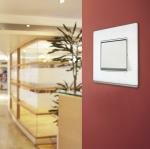
In the electrical sector the term ‘wireless’ is not perhaps the most useful one – becoming, as it has, a generic for all forms of communications in which electromagnetic waves or RF (rather than some form of wire) carry a signal over part or the entire communication path; and is obviously particularly associated with radio.
However, the use of wireless technology has increased exponentially over the past few decades and is ubiquitous in the home and workplace – not least through the uptake of mobile phones and access to the Internet. That said, the use of wireless to deliver control and management of electrical services has been slower coming – if one excludes the established detection market.
However, developments in more accessible technology (both in terms of price and user-friendliness) combined with environmental pressures (i.e. the need for energy saving) has seen the development of wireless products – beyond PIRs etc – more suited to ‘everyday’ applications.
Recent developments
Among the most recent developments are those with wireless control of light switching; based around either Point-to-Point (P2P) or ‘mesh’ networks. Point-to-point generally refers to a connection restricted to two endpoints. Mesh networking is a way to route data, voice and instructions between nodes.
New technologies offering lighting control revolve around wireless products – which can be P2P or mesh – operating in unlicensed frequency bands; and are designed to bring about the existence of a broad range of interoperable wireless monitoring and controlling products for use in and around residential, commercial and industrial buildings.
At the heart of this is the efficient exploitation of slight changes in the environmental – or ambient – energy, using the principles of energy harvesting. The most pervasive example of this is the battery-free wireless light switch. The benefits of such technology include almost instant switch installation; total location flexibility of light switches within buildings; and easy relocation, re-installation and considerable cost-savings when churning office and other commercial spaces. Such switches are also incredibly low maintenance thanks to the lack of batteries (that would need replacing) and lack of wiring in the wall.
How it works
Such switches essentially comprise two components: a self powered switch, and an RF receiver. The receiver is installed at the lighting fixture and wired into the lighting circuit at the time of ceiling installation. The switch is then mounted, using either adhesive pads – for super-fast fixing or onto awkward surfaces like marble or glass – or with screws if additional security is necessary.
The switch is simply aligned to the receiver by setting it into ‘learn mode’ and pressing the rocker. The switch is now wirelessly dedicated to the fixture in question. One receiver can be programmed so it can be operated by up to 30 switches; while, conversely, any number of receivers can be activated by a single switch. Where signals may be obstructed by impervious materials such as granite or steel, repeater units are available which will divert and/ or extend transmissions around a building.
Switch signals and sensor information are reliably transmitted and interference from other signals can be excluded. Devices also have unique 32-bit serial numbers, so local interference is avoided by ‘training’ a receiver to its specific transmitters. The frequency used for the majority of the devices is 868.3 MHz.
Numerous applications
These wireless, battery-free switches are suitable for a wide range of applications and installation environments: from office new build and refurbishment which may have a need to re-arrange space periodically, or glass partitions – preventing the use of wired devices – through to conservation or listed environments where chasing wires is not possible.
They also lend themselves to domestic extensions or conservatories where switch location may be an issue or – again – where areas of glass feature; and, finally, one-off or ‘portable’ locations such as yachts, park homes, caravans, exhibition stands and temporary buildings where a fast, flexible solution is required.
Furthermore, the switches aid compliance with Building Regulations such as Part L by providing for localised control of lighting and integration with lighting management systems and other networks covering areas such as heating and air-conditioning. They also help with meeting Part M requirements thanks to their immense flexibility when positioning them.
Total flexibility
‘Self powered’ switches mean no wires, no batteries and no fuss. They will add a new level of convenience to the way switching is treated within commercial spaces; and deliver a host of benefits to the specifier, installer and facilities manager – whether seeking products permitting super-fast installation; to mount switches on glass; or total flexibility over switch location in partitioned offices subject to re-arrangement.
